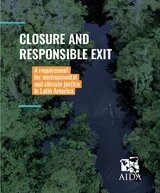CLOSURE AND RESPONSIBLE EXIT
No natural resource (material or energy) extraction project lasts forever. Its useful life is subject to many variables, including endogenous factors -such as the amount of resource reserves or the extraction rate- and exogenous factors -such as decisions to address the climate crisis, the decrease in demand, financial problems, etc.- that condition the moment in which the project must close or the moment in which a stakeholder in its value-andsupply chain must leave. Regardless of the length of the project’s useful life or how it may be affected, a closure process responsible with the natural environment and society must be contemplated, which must be desired and promoted by all the stakeholders involved.
This issue is even more relevant in the context of the climate crisis we are experiencing, which urges us to implement measures to manage it in the short, medium and long term. Many of the actions required to meet greenhouse gas (GHG) mitigation goals are related to energy transition, which implies, in general terms, at least two things: 1) the substitution of projects for fossil fuel extraction and use and 2) the promotion of low-emission renewable energies, which are associated with mineral extraction. In both scenarios, issues of closure and exit are of great importance. In the case of fuels, it is necessary to include specific and enforceable closure obligations into existing projects. In the case of projects for renewable energy and mineral extraction for transition, closure should be included from the planning stage through the prefeasibility stage and integrated into environmental impact assessments (EIA) and beyond. The discussion on environmental protection and climate management in Latin America does not only involve talking about how projects should reach the territories. It must also answer the following questions: What should project
closure and exit look like? How to make closure and exit planned project processes rather than makeshift decisions? How to make closure and exit accountable and fair, regardless of the phase and situation in which they occur?
In both extraction and generation projects the role of their promoters, whether public or private, is essential. Likewise, the obligation of supervision and oversight of the States is very important for the protection and guarantee of the rights of those who may be affected. On occasions, the responsibility for the exit includes other key stakeholders that are part of the value-and-supply chains of the projects: investors, insurers, distributors and buyers, among others.
In Latin America, there have been important advances in regulating aspects related to the authorization, beginning and implementation of mining and energy projects. In these phases, environmental principles such as prevention and precaution, as well as rights such as prior consultation and free, prior and informed consent, and access rights, have played a crucial role in determining the viability and progress of the projects, as well as in protecting and guaranteeing the rights of the communities in the region. However, experience has shown that there are significant challenges for the closure and exit processes to be responsible with the ecosystems and communities involved. Indeed, the lack of a closure process, as well as the lack of clarity about the obligations surrounding the processes of social transition and the overcoming of economic dependence, are complex obstacles that can
exacerbate environmental and social impacts.
